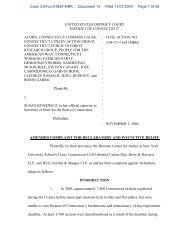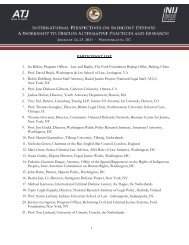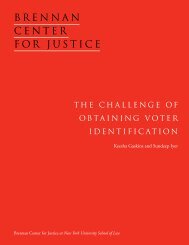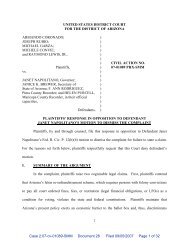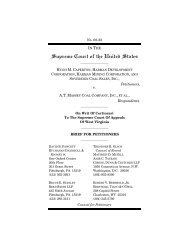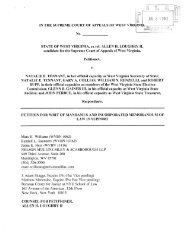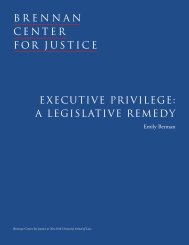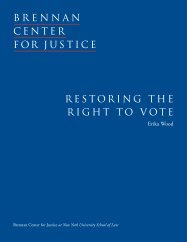THE NEW YORK STATE LEGISLATIVE PROCESS: AN ...
THE NEW YORK STATE LEGISLATIVE PROCESS: AN ...
THE NEW YORK STATE LEGISLATIVE PROCESS: AN ...
You also want an ePaper? Increase the reach of your titles
YUMPU automatically turns print PDFs into web optimized ePapers that Google loves.
xii <strong>THE</strong> <strong>NEW</strong> <strong>YORK</strong> <strong>STATE</strong> <strong>LEGISLATIVE</strong> <strong>PROCESS</strong>: <strong>AN</strong> EVALUATION <strong>AN</strong>D BLUEPRINT FOR REFORM<br />
FEW CONFERENCE COMMITTEES:<br />
TOXIC BROWNFIELDS<br />
In a properly functioning legislature,<br />
conference committees are routinely<br />
convened to reconcile differences<br />
between bills passed by the two<br />
legislative chambers. When they<br />
are bypassed, which is business as<br />
usual in Albany, the damage can<br />
be serious. For over a decade,<br />
legislation to clean up more than<br />
800 contaminated industrial sites<br />
across the state known as “brownfields”<br />
remained stalled in the legislature<br />
despite widespread support,<br />
ongoing toxic hazards and economic<br />
stagnation in communities. With<br />
no conference committee system,<br />
differences between the Senate’s<br />
and Assembly’s separate bills went<br />
unresolved. Finally, in June 2003,<br />
the Governor, Speaker, and Majority<br />
Leader reached agreement behind<br />
closed doors and then rushed final<br />
passage of the law through the<br />
Assembly and Senate without<br />
meaningful opportunities for debate<br />
or even review. Acting in extreme<br />
haste without adequate review,<br />
the Senate passed the wrong version<br />
of the bill. The legislative session<br />
came to an end, and the people<br />
of New York still were without a<br />
brownfields law. Three months<br />
later, the Senate convened for a<br />
special one-day session to correct its<br />
mistake. The cost to New Yorkers?<br />
Harmful delay in resolving and<br />
passing legislation that protects<br />
communities from environmental<br />
threats and economic stagnation.<br />
frequently to bypass the State’s constitutional aging requirement. From 1997<br />
through 2001, a message of necessity was requested and obtained for at least<br />
one chamber’s vote on 26.9% of the major legislation that was passed.<br />
Inadequate Review. For the 308 major laws passed from 1997 through 2001,<br />
the median number of days between a bill’s introduction and its passage was<br />
10 in the Assembly and 35 in the Senate. In the Assembly, 124 out of the 308<br />
laws (i.e., 40.3%) were passed within five days or fewer of their introduction.<br />
In the Senate, 85 laws (i.e., 27.6%) passed within five days or fewer. Notably,<br />
in both 1997 and 2000, the Assembly spent a median of just two days on<br />
major legislation between introduction and final passage.<br />
Together, these practices prevent New Yorkers’ elected representatives from fully<br />
reviewing, considering, debating, and amending legislation before it becomes law.<br />
As a result, legislators cannot fully represent their constituents’ interests and are<br />
forced to allow flawed legislation to be passed.<br />
■■ PROPOSED RULES CH<strong>AN</strong>GES:<br />
■ Votes by members shall be recorded and counted only when the member<br />
is physically present in the chamber at the time of the vote and personally<br />
indicates whether s/he wishes to vote “aye” or “nay.” Such votes shall be<br />
made available as a public record.<br />
■ No messages of necessity shall be approved by the Governor unless (a) at least<br />
two thirds of the elected members of the chamber in question have voted to<br />
request such message and (b) the Governor has personally reviewed and<br />
signed such message as intended by the Constitution.<br />
■ Debate on a bill shall not be limited to less than five hours and shall be so<br />
limited only by a majority vote of the elected members of the chamber.<br />
■ When considering bills, legislative party conferences shall be convened and<br />
remain in open session unless closed with respect to a specific bill by a vote of<br />
four fifths of the elected members of the conference.<br />
PROBLEM # 4<br />
■ FEW CONFERENCE COMMITTEES<br />
Conference committees are widely used in the U.S. Congress and in other state<br />
legislatures to reconcile differences between the bills passed by the two houses of<br />
a legislature to produce a single law that can be passed by both. In New York,<br />
however, conference committees have been used only rarely since the first<br />
decades of the 20th century. Instead, to pass a bill into law one chamber must<br />
move to substitute the other chamber’s version of the bill for its own, with the<br />
leaders of the two chambers working out any differences directly.



